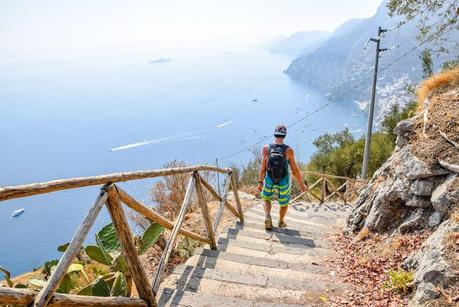
Path of the Gods
The Path of the Gods, named the Sentiero degli Dei in Italian, is a hiking path that takes its name from the beautiful scenery found on the walk. It links the towns of Agerola to Nicolle, ending in Positano and is a gentle decline walk that takes around 3 hours to complete, a 7.8-kilometre easy hike all up. You can begin by reaching Agerola from Amalfi, taking a Sita bus and following the white and red signs that line the track. Before you start the track though, be sure to try Agerola’s premier fior di latte, a cheese especially popular in this area, perhaps pick up a focaccia on the way? As you begin walking the Path of the Gods you will pass farmland with sheep and goats grazing the fields, however the scenery changes somewhere near Praiano to a more familiar Mediterranean landscape. Your view will change into green fields ripe with olive and lemon trees, and the scent of rosemary wafting gently through the air. It’s here when the path gets a little more difficult with a greater number of ascents and descents however the wildflowers and abandoned ancient stone houses, you’ll discover along the way makes the journey worth it. It’s recommended to start this trail early to beat the crowds and the heat, and who was it that made the track? Ancient Greeks who settled there used the path for transport, as well as monks who lived in secluded monasteries on the way.
Blue Grotto
The Blue Grotto has long been regarded as one of Capri’s most visited attractions, if not the highest rated. The mouth of the sea cavern is around two metres wide and a meter high which is why your captain will make you lie down to pass through the opening. Once you get into the grotto, the space is much wider at about 60 metres long. Jet blue water reflects off the light creating a crystal blue reflection with silver ripples in it. The best time to visit is between 12-2pm when the light is the most illuminated. You’ll find however that the whole experience inside the cave only lasts about 5 minutes but the wait outside to get can be much longer due to the crowds. If you plan on going in the off season, you can check the closure periods down at the Marina Grande and please keep in mind that swimming in the grotto is not permitted as it is unsafe. The history of the Grotto is rich, Emperor Tiberius was known to have used the grotto as a personal pool, bringing his lovers there and using the site as a marine temple. For many years after this, it was believed that there were demons in the grotto and so sailors steered clear of the area. It wasn’t till much later that the grotto was opened for tourism purposes.
Furore
Furore is classified as a non-town due to the fact that it has no main town center or piazza, however this only adds to its quiet charm. Houses are sprinkled along the rocks, and lemon trees line the area around. The town gets its name from the Italian word ‘furore’ which means fury. The fishing village was originally settled by exiles who were sent to live in the area from Amalfi and most of these people were good farmers and artists who built the village up to what it is today. Once an impenetrable fortress that was hidden by invaders from the sea, Furore is usually quiet and its main feature is the fjord, the only one in Italy which separates Furore by 2 cliffs that are only linked by a 98 foot bridge. It’s only 10 kilometres from Amalfi so make your way to the UNESCO World Heritage Site to spend a day at the secluded, pretty beach, named one of the most beautiful in the country.
Faraglioni Rocks
It’s said that as you sail your way pass the Faraglioni Rocks, if you make a wish and kiss your sweetheart you will be granted good luck. This seems fair enough considering the sheer beauty and magic one feels when looking at the dramatic rocks. Three large rock formations that average in height in around 100 metres line the waters of Capri and is home to the elusive blue coloured lizard that can only be found on these rocks. The three rocks are named Stella, Faraglione di Mezzo and Faraglione di Furori with the middle rock having a natural arch that can fit a small passenger boat.
Villa Cimbrone
The grand Villa Cimbrone is a 15-minute walk from Ravello’s central square and while it is now a hotel and restaurant, visitors can still walk around the English gardens and view the famed infinity terrace, one of the best views in the world. The villa dates back to the 11th century and what you see today is much the work of Lord Grimthrope, an English diplomat who had a green thumb and created the English style gardens. Lots of statues and walkways that leads to temples can be viewed today as well as the infinity terrace which makes you feel as if you are floating as you look out to the sea, where the line between the sky and sea is virtually non-existent.
Advertisements
